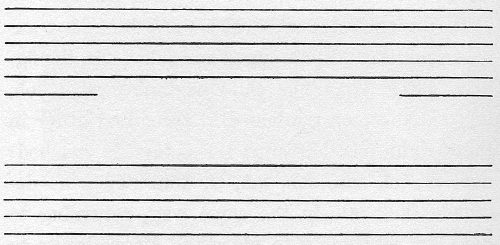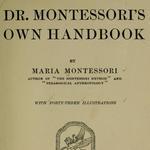Chapter 05 - The Reading of Music
Dr. Montessori's Own Handbook - Restoration
# [Chapter 05 - The Reading of Music](https://montessori-international.com/s/montessoris-own-handbook/wiki/Chapter+05+-+The+Reading+of+Music)
When the child knows how to read, he can make the first application of this knowledge to the reading of the names of musical notes.
In connection with the material for sensory education, consisting of the series of bells, we use a didactic material, which serves as an introduction to musical reading. For this purpose, we have, in the first place, a wooden board, not very long, and painted pale green. On this board, the staff is cut out in black, and in every line and space are cut round holes, inside each of which is written the name of the note in its reference to the treble clef.
There is also a series of little white discs which can be fitted into the holes. On one side of each disc is written the name of the note (do, re, mi, fa, sol, la, ti, do).
The child, guided by the name written on the discs, puts them, with the name uppermost, in their right places on the board and then reads the names of the notes. This exercise he can do by himself, and he learns the position of each note on the staff. Another exercise that the child can do at the same time is to place the disc bearing the name of the note on the rectangular base of the corresponding bell, whose sound he has already learned to recognize by ear in the sensorial exercise described above.

> Fig. 39.––Dumb Keyboard.
Following this exercise, there is another staff made on a board of green wood, which is longer than the other and has neither indenture nor signs. A considerable number of discs, on one side of which are written the names of the notes, are at the disposal of the child. He takes up a disc at random, reads its name, and places it on the staff, with the name underneath, so that the white face of the disc shows on the top. By the repetition of this exercise, the child is enabled to arrange many discs on the same line or in the same space. When he has finished, he turns them all over so that the names are outside, and so finds out if he has made mistakes. After learning the treble clef the child passes on to learn the bass with great ease.

> Fig. 32 - The Musical Staff \[A\]\
> \[A\] The single staff is used in the Conservatoire of Milan and utilized in the Perlasca method.
To the staff described above can be added another similar to it, arranged as is shown in the figure. (Fig. 32.) The child, beginning with doing, lays the discs on the board in ascending order in their right position until the octave is reached: do, re, mi, fa, sol, la, ti, do. Then he descends the scale in the same way, returning to ***do***, but continuing to place the discs always to the right: sol, fa, mi, re, do. In this way, he forms an angle. At this point he descends again to the lower staff, ti, la, sol, fa, mi, re, do, then he ascends again on the other side: re, mi, fa, sol, la, ti, and by forming with his two lines of discs another angle in the bass, he has completed a rhombus, “the rhombus of the notes.”
After the discs have been arranged in this way, the upper staff is separated from the lower. In the lower, the notes are arranged according to the bass clef. In this way the first elements of music reading are presented to the child, reading which corresponds to ***sounds*** with which the child’s ear is already acquainted.
For the first practical application of this knowledge, we have used in our schools a miniature pianoforte keyboard, which reproduces the essentials of this instrument, although in a simplified form, so that they are visible. Two octaves only are reproduced, and the small keys are proportioned to the hand of a little child of four or five years, as the keys of the common piano are proportioned to those of the adult. All the mechanism of the key is visible. (Fig. 39.) On striking a key, one sees the hammer rise, on which is written the name of the note. The hammers are black and white, like the notes.
With this instrument it is very easy for the child to practice alone, finding the notes on the keyboard corresponding to some bar of written music, and following the movements of the fingers made in playing the piano.
The keyboard in itself is mute, but a series of resonant tubes, resembling a set of organ pipes, can be applied to the upper surface, so that the hammers striking these produce musical notes corresponding to the keys struck. The child can then pursue his exercises with the control of the musical sounds.
## [Didactic Material for Musical Reading](https://montessori-international.com/s/montessoris-own-handbook/wiki/Chapter+05+-+The+Reading+of+Music#didactic-material-for-musical-reading)

> Fig. 33. On the wooden board, round spaces are cut out corresponding to the notes. Inside each of the spaces, there is a figure. On one side of each of the discs is written a number and on the other is the name of the note. They are fitted by the child into the corresponding places.

> Fig. 34. The child next arranged the discs in the notes cut out on the staff, but there are no longer numbers written to help him find the places. Instead, he must try to remember the place of the note on the staff. If he is not sure he consults the numbered board (Fig. 33).

> Fig. 35. The child arranged on the staff the semitones in the spaces which remain where the discs are far apart: do-re, re-mi, fah-soh, soh-la, la-ti. The discs for the semitones have the sharp on one side and the flat on the other, e.g., re♯-mi♭ are written on the opposite sides of the same disc.

> Fig. 36. The children take a large number of discs and arrange them on the staff, leaving uppermost the side which is blank, i.e., the side on which the name of the note is not written. Then they verify their work by turning the discs over and reading the name.

> Fig. 37. The double staff is formed by putting the two staves together. The children arrange the notes in the form of a rhombus.

> Fig. 38. The two boards are then separated and the notes remain arranged according to the treble and bass clefs. The corresponding key signatures are then placed upon the two different staves.
> ##### **The license of this page:**
>
> This page is part of the “**Montessori Restoration and Translation Project**”.
>
> Please [support](https://ko-fi.com/montessori) our “**All-Inclusive Montessori Education for All 0-100+ Worldwide**” initiative. We create open, free, and affordable resources available for everybody interested in Montessori Education. We transform people and environments to be authentic Montessori worldwide. Thank You!
>
> [](http://creativecommons.org/licenses/by-nc-sa/4.0/)
>
> **License:** This work with all its restoration edits and translations is licensed under a [Creative Commons Attribution-NonCommercial-ShareAlike 4.0 International License](http://creativecommons.org/licenses/by-nc-sa/4.0/).
>
> Check out the **Page History** of each wiki page in the right column to learn more about all contributors and edits, restorations, and translations done on this page.
>
> [Contributions](https://mariamontessori.xyz/s/montessorix/wiki/page/view?title=Contribute+to+Montessori+X) and [Sponsors](https://mariamontessori.xyz/s/montessorix/wiki/page/view?title=Support+Montessori+X) are welcome and very appreciated!
>
> ### The book itself is protected under **The Project Gutenberg License**
>
> [https://www.gutenberg.org/policy/license.html](https://www.gutenberg.org/policy/license.html)
>
> To protect the Project Gutenberg-tm mission of promoting the free distribution of electronic works, by using or distributing this work (or any other work associated in any way with the phrase “Project Gutenberg”), you agree to comply with all the terms of the Full Project Gutenberg-tm License available with this file or online at [www.gutenberg.org/license](https://www.gutenberg.org/license)
>
> **This eBook is for the use of anyone anywhere in the United States and most other parts of the world at no cost and with almost no restrictions whatsoever. You may copy it, give it away, or re-use it under the terms of the Project Gutenberg License included with this eBook or online at [www.gutenberg.org](http://www.gutenberg.org/). If you are not located in the United States, you’ll have to check the laws of the country where you are located before using this ebook.**
>
> Read this book on …
>
> **[Project Gutenberg](https://www.gutenberg.org/)**
>
> * [https://www.gutenberg.org/ebooks/29635](https://www.gutenberg.org/ebooks/29635)
>
> **[Archive.org](http://archive.org/)**
>
> * [https://archive.org/details/drmontessorisow01montgoog/](https://archive.org/details/drmontessorisow01montgoog/)
> * [https://archive.org/details/drmontessorisown01mont/](https://archive.org/details/drmontessorisown01mont/)
> * [https://archive.org/details/drmontessorisown00mont](https://archive.org/details/drmontessorisown00mont)
> * [https://archive.org/details/drmontessorisown29635gut](https://archive.org/details/drmontessorisown29635gut)
>
> **[Guides.co](https://guides.co/)**
>
> * [https://guides.co/g/montessori-handbook/31826](https://guides.co/g/montessori-handbook/31826)
* [Dr. Montessori's Own Handbook](https://montessori-international.com/s/montessoris-own-handbook/wiki/English "Dr. Montessori's Own Handbook") - English Restoration - [Archive.Org](https://archive.org/details/drmontessorisown01mont/page/n5/mode/2up "Dr. Montessori's Own Handbook on Archive.Org") - [Project Gutenberg](https://www.gutenberg.org/ebooks/29635 "Dr. Montessori's Own Handbook on Project Gutenberg")
* [0 - Chapter Index - Dr. Montessori's Own Handbook - Restoration](https://montessori-international.com/s/montessoris-own-handbook/wiki/0+-+Chapter+Index+-+Dr.+Montessori%27s+Own+Handbook+-+Restoration)
* [Chapter 00 – Dedication, Acknowledgements, Preface](https://montessori-international.com/s/montessoris-own-handbook/wiki/Chapter+00+%E2%80%93+Dedication%2C+Acknowledgements%2C+Preface)
* [Chapter 01 - Introduction - Children's House - The Method](https://montessori-international.com/s/montessoris-own-handbook/wiki/Chapter+01+-+Introduction+-+Children%27s+House+-+The+Method)
* [Chapter 02 - Motor Education](https://montessori-international.com/s/montessoris-own-handbook/wiki/Chapter+02+-+Motor+Education)
* [Chapter 03 - Sensory Education](https://montessori-international.com/s/montessoris-own-handbook/wiki/Chapter+03+-+Sensory+Education)
* [Chapter 04 - Language and Knowledge of the World](https://montessori-international.com/s/montessoris-own-handbook/wiki/Chapter+04+-+Language+and+Knowledge+of+the+World)
* [Chapter 05 - The Reading of Music](https://montessori-international.com/s/montessoris-own-handbook/wiki/Chapter+05+-+The+Reading+of+Music)
* [Chapter 06 - Arithmetic](https://montessori-international.com/s/montessoris-own-handbook/wiki/Chapter+06+-+Arithmetic)
* [Chapter 07 - Moral Factors](https://montessori-international.com/s/montessoris-own-handbook/wiki/Chapter+07+-+Moral+Factors)


